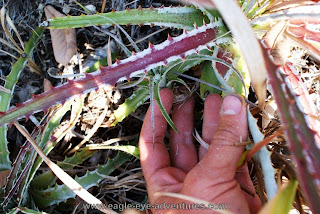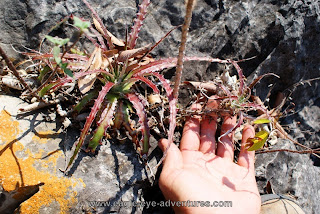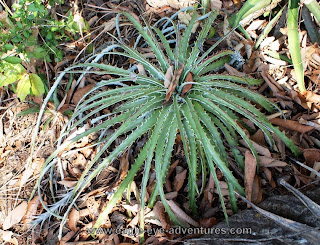 |
| Stolon hanging down over the rocks. |
A handful of Hechtia species are stoloniferous. Some species always seem to be stoloniferous as a whole, some species have populations seem to be stoloniferous, and some species seem to have just a portion of a population that will be stoloniferous. Stolons are a feature that always catches my attention!
Hechtia glomerata is a very widespread species. It runs nearly the complete north-south distribution of the genus. As you would imagine, over such a wide range and in so many different habitats there is a lot of variability within the species. Some populations in the northern Mexican states mature at only ~12" in diameter or so while some in the southern state of Chiapas can be 6' across (or more!). Some produce offsets profusely while others stay solitary.
 |
| Stoloniferous Hechtia glomerata. |
On a trip a couple of years ago, I found a small population of Hechtia glomerata in the state of Queretaro (in north-central region) that were stoloniferous. Scrambling through the plants I was amazed at the color and the fact that most of the plants seemed to have bright white margins on their leaves made of thick trichomes. It took surprisingly long for me to realize that they were sending out offsets on slender stolons! Once I noticed, it was as obvious as could be. Nice to be so excited with the plants even before noticing this cool trait being expressed.
 |
| A small Hechtia glomerata producing a pup on a stolon |
Even as small plants they were already producing the stoloniferous offsets. It makes sense that they would be selected for this trait as once a seedling becomes established in a crevice that has enough soil and detritus to grow it might not have enough space to make a clump with normal pups, but there is plenty of space on the baking rock where other plants can't grow.
 |
| Seed pods |
 |
| The Hechtias growing with Agaves. |
In the picture above and to the left you can see that the rocks are the refuge for the Hechtias. They would not be able to out compete the grasses and survive in the more flat soil around the rocks. For the most part, only the Hechtias and Agaves could survive growing on and among the rocks. No plants were actively blooming, but from the old female inflorescence that was releasing seed we can see the typical flowers clustered into glomerules (hence the name).
 |
| Inflorescence forming on the stoloniferous Hechtia glomerata |
This plant would probably have flowers ready in another couple of weeks or a month, but this is definitely an inflorescence forming and not a stoloniferous offset. Sometimes they are confusing to tell apart when they are first initiated.
 |
| Stoloniferous pup searching for more light. |
One somewhat larger plant somehow was able to grow int he shade of a tree a little ways from the rocks. You can tell the effects of it growing in richer soil and in a more shaded environment by its size, its nice bright green color, and the length of the stolon reaching for a brighter spot (to the bottom left corner).
No comments:
Post a Comment